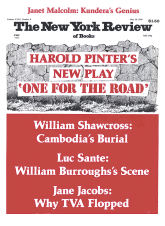In response to:
All the King's Men from the March 15, 1984 issue
To the Editors:
Though not much disposed to quarrel with Professor Daniel Albright’s review of my Land and Literature of England [NYR, March 15], I feel bound to comment on a couple of points.
The book is said to neglect biographies of individual authors. Indeed, it does, though repeatedly urging the reader to explore all the biographies he possibly can. The object of the book was to outline the history and literature of England, in relation to one another, taking only 500 pages to do it. (The students for whom it was primarily intended cannot possibly be asked to do more collateral reading than that for a course which already demands the study of a heavy load of basic texts.) This meant, of course, extravagant compression—literally, the squeezing of superfluous “and’s” and “the’s” out of the text. To add to it the biographies of several hundred authors would have been absurd and impossible.
Professor Albright declares that the portrait of Queen Elizabeth occupies forty-three pages as contrasted with only two for Chaucer; this could give a grotesque impression of the book, and is quite erroneous. The entire reign of Queen Elizabeth occupies two chapters, or fifty-seven pages; apart from the queen herself, it deals with such matters as John Knox, Mary Queen of Scots, the rise of Puritan feeling, the Spanish Armada, Martin Marprelate, as well as the work of Spenser, Hooker, Shakespeare and the dramatists, Sidney, Drayton, Davies, Raleigh, and many others. There is a one-page sketch of the queen (pp. 165–166) and a summary passage at her death (p. 186).
Professor Albright also attributes to me the view that the Bayeux tapestry is the principal source of our knowledge of the Battle of Hastings. He may have got this impression from a caption under a picture, but it is ridiculously false. Could anyone possibly suppose that Professor E.A. Freeman’s fifteen-volume History of the Norman Conquest—not to mention all the studies critical of it—reposed on nothing but a strip of cloth? What the caption actually says is that the ladies got a lot of vivid detail into their needlework pictures, as indeed they did.
Still, the review, though loosely written (ah, the wordage I could have squeezed out of it), was not unfair. The conditions under which the book was to be used required sharp images, bold contrasts, many omissions, and an occasional striking detail, to keep the weary student awake. As I carefully explained in the Foreword, it is an introductory book; and an introductory book which led its readers only into the arms of Morpheus would not be accomplishing much.
Robert M. Adams
Santa Fe, New Mexico
Daniel Albright replies:
Professor Adams’s ill ease on the subject of his neglect of authors’ biographies does not seem to spring from my review, for I explained there just why his decision was a reasonable one. He may well be correct in believing that readers can be educated by repeated exhortations to educate themselves. T.S. Eliot may well have been correct in believing that the mind of the poet was only a shred of platinum. But Dr. Johnson would have been saddened to think that the lives of the poets added up to a little heap of scrap metal.
My purpose in the review was not to indict the decision to let writers atrophy while politicians grow fat, but to show the consequences of it. I cannot be sure whether the exact ratio of royalty to genius is 43 to 2, or 10 to 1, or 55 to 9, but my statistics reflect the book’s true emphasis: the mighty king overwhelms the frail poet, John Skelton is but a gnawed mutton bone brandished by Henry VIII’s huge Holbein arm. As to the other matter that arouses Professor Adams—the Bayeux tapestry—I did not mean to accuse Professor Adams of ignorance of any immense scholarly enterprise. Those readers who grasp irritably after facts will be reassured to learn that Professor Adams’s story of the Battle of Hastings is a sketch derived from a fifteen-volume history, not a cartoon derived from a cartoon.
This Issue
May 10, 1984



